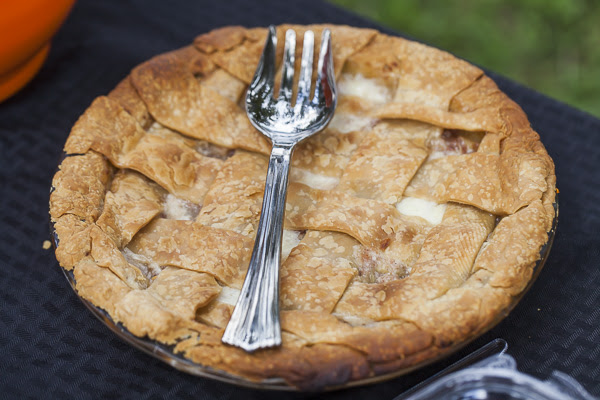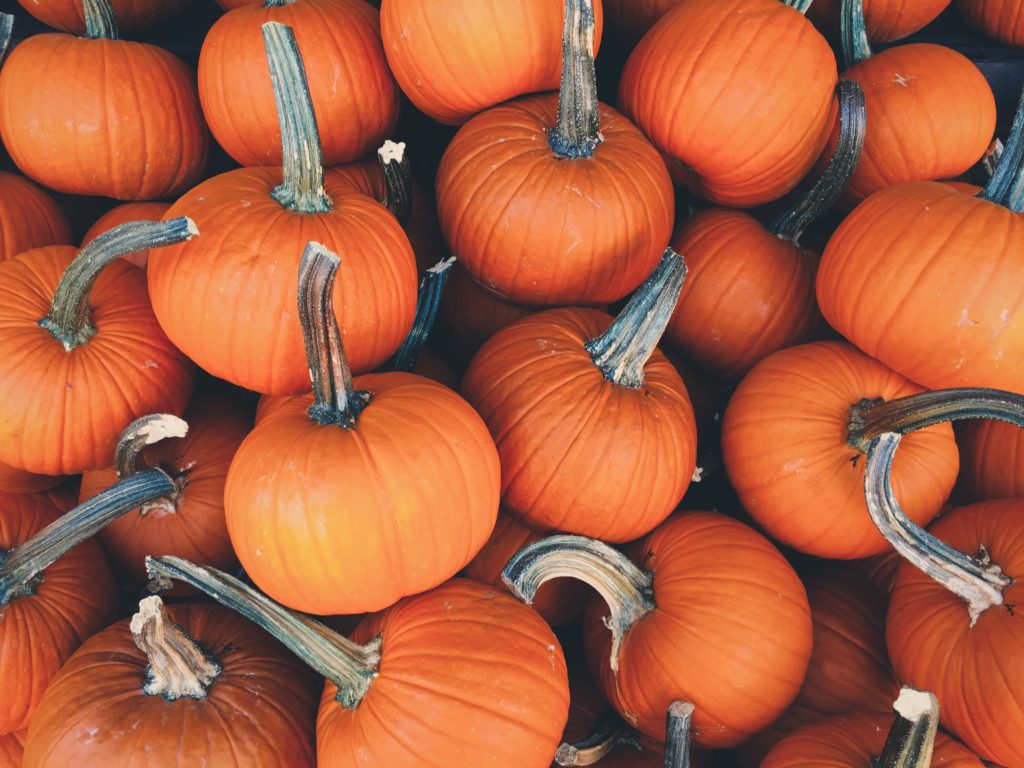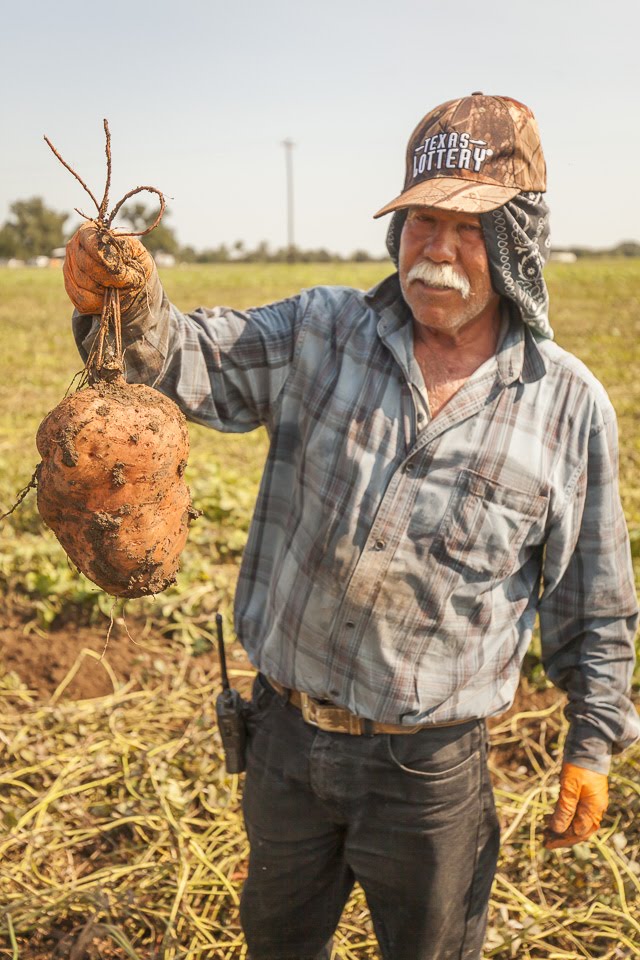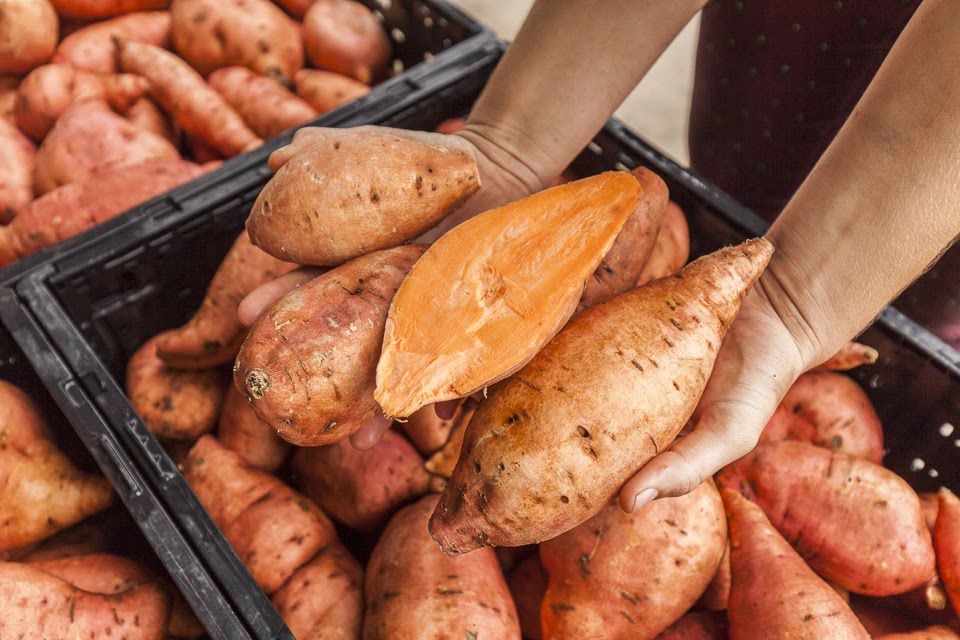
WEIRD THANKSGIVING FOOD, EXPLAINED
11/22/19 — Ada Broussard
Before we jump into some of the oddities of the Thanksgiving table, we wanted to remind you that the holiday is upon us. As if you could forget, but just in case. This means the JBG farm crew is taking the day off on Thursday, and our CSA delivery schedule will be a bit different next week. CSA Members, please make sure you’re aware of the changes to delivery schedules that can be seen here.
![]() To be clear, pie is not a weird Thanksgiving food. Pie is a perfect Thanksgiving food. Photo by Scott Gordon.
To be clear, pie is not a weird Thanksgiving food. Pie is a perfect Thanksgiving food. Photo by Scott Gordon.
We all know the American classics. Turkey, stuffing, rolls. Mashed potatoes, gravy and pumpkin pie. And then there are the oddballs - green bean and sweet potato casseroles. To a foreigner looking in, the addition of canned onion rings atop green beans and sugary marshmallows atop fresh sweet potatoes may be the most mind-boggling American tradition. As farmers, we grow food for a living. Our own Thanksgiving tables always reflect a balance of seasonal dishes (using the veggies that can actually thrive in Texas during this time of year) as well as some of the classics that we just can’t holiday without.
But if you want the turkey-day truth, many of the traditional dishes we know and love don’t quite reflect the Texas growing season in mid November. Potatoes, for example, are a spring crop for us Texan farmers. Might we suggest roasting and mashing some rutabaga or Hakurei turnips, instead. Slathered in gravy and mixed with butter, guests may not even notice the impostor. Pumpkins are a pain to grow during the fall due some mildew pressure and the short growing season, but you can make sweet potato pie that will fill this gap. Usual additions to stuffing include celery (almost impossible to grow in Texas, at any time), but diced chard stems or bok choy are an awesome, seasonal substitute. We know it sounds weird, just trust us. Green beans are not frost tolerant, and local green beans on a Thanksgiving table would require an unusually mild fall. Most farmers aren’t interested this degree of risk. We trust you’ll find the perfect balance this year between seasonal standards and old-time classics, but every year around this time we always wonder - if all of these vegetables are hard to grow at this time of year, how in the world did they manage to make their way onto the “classics” list? And where do the marshmallows come in? We’re taking a closer look at three such dishes.
Tourte of Pompion (Pumpkin) – Boile it with good milk, pass it through a straining pan very thick, and mix it with sugar, butter, a little salt and if you will, a few stamped almonds; let all be very thin. Put it in your sheet of paste; bake it. After it is baked, besprinkle it with sugar and serve.
![]() Stock photo of pumpkins grown by some other farm. We would have trouble growing this crop for a fall harvest.
Stock photo of pumpkins grown by some other farm. We would have trouble growing this crop for a fall harvest.
Fast forward to Civil War America when Abraham Lincoln made Thanksgiving an official national holiday. Pumpkins, which were a crop more easily grown in northern regions during the fall, were already a mainstay of unofficial Thanksgiving feasts. Though the holiday didn’t have as much of a stronghold in the South up until this point, after the institution of the official holiday, the pie, and feasting traditions in general, traveled southward. In 1928 Libby’s started canning pumpkin. And now the whole country is besprinkling this classic.
![]() One of our favorite JBG sweet potato photos of all time. Galdino won the lottery with this one!
One of our favorite JBG sweet potato photos of all time. Galdino won the lottery with this one!
Sweet potatoes are native to central and north America, and were eaten (and farmed) in the Americas long before any pilgrims boarded a ship. (On a side note, here is a really interesting article pointing to evidence that sweet potatoes traveled across the Pacific...on a boat… before Columbus even stepped foot in America. ). African slaves in the South gravitated towards the orange tuber as it resembled yams, a vegetable native to their homes, and the vegetable grew well in the warmer Southern climates. The vegetable rooted itself in southern kitchens, and after Thanksgiving officially became a holiday, traditions of sweet potatoes moved north (just as pies of pumpkin traveled south). In fact, many southerners used sweet potatoes in lieu of pumpkins to pie.
But why the sugary pillows of marsh? . According to Saveur, marshmallows, once an expensive candy for the elite, started to be mass-produced in 1917 and manufactures released recipe booklets for everyday marshmallow recipes (as if that should be a thing) and here the sweet potato marshmallow duo was born. “Right away, Americans divided on whether that was a good thing. Southerners appeared to respect sweet potatoes too much to pair them with candy.” . In this divide, we’d like to think that Southerns had the right idea. Over 100 years later, marshmallows are still a relevant Thanksgiving topping. If you just must, we do like this recipe. (Spoiler: marshmallows are used in moderation).
![]() See these potatoes? They were planted, picked, and washed by hand. Do you really want to bake them topped with candy?
See these potatoes? They were planted, picked, and washed by hand. Do you really want to bake them topped with candy?
![]() A beautiful harvest of JBG green beans. From May.
A beautiful harvest of JBG green beans. From May.
Which Thanksgiving classics can’t you live without? What seasonal veggies are gracing your table? If you share any photos on Facebook or Instagram, be sure to tag the farm (@jbgorganic) so we can see what you’re up to! As always, thanks for reading and happy Thanksgiving!
 To be clear, pie is not a weird Thanksgiving food. Pie is a perfect Thanksgiving food. Photo by Scott Gordon.
To be clear, pie is not a weird Thanksgiving food. Pie is a perfect Thanksgiving food. Photo by Scott Gordon.
We all know the American classics. Turkey, stuffing, rolls. Mashed potatoes, gravy and pumpkin pie. And then there are the oddballs - green bean and sweet potato casseroles. To a foreigner looking in, the addition of canned onion rings atop green beans and sugary marshmallows atop fresh sweet potatoes may be the most mind-boggling American tradition. As farmers, we grow food for a living. Our own Thanksgiving tables always reflect a balance of seasonal dishes (using the veggies that can actually thrive in Texas during this time of year) as well as some of the classics that we just can’t holiday without.
But if you want the turkey-day truth, many of the traditional dishes we know and love don’t quite reflect the Texas growing season in mid November. Potatoes, for example, are a spring crop for us Texan farmers. Might we suggest roasting and mashing some rutabaga or Hakurei turnips, instead. Slathered in gravy and mixed with butter, guests may not even notice the impostor. Pumpkins are a pain to grow during the fall due some mildew pressure and the short growing season, but you can make sweet potato pie that will fill this gap. Usual additions to stuffing include celery (almost impossible to grow in Texas, at any time), but diced chard stems or bok choy are an awesome, seasonal substitute. We know it sounds weird, just trust us. Green beans are not frost tolerant, and local green beans on a Thanksgiving table would require an unusually mild fall. Most farmers aren’t interested this degree of risk. We trust you’ll find the perfect balance this year between seasonal standards and old-time classics, but every year around this time we always wonder - if all of these vegetables are hard to grow at this time of year, how in the world did they manage to make their way onto the “classics” list? And where do the marshmallows come in? We’re taking a closer look at three such dishes.
Pumpkin pie:
The earliest versions of this dish in association with autumnal celebrations were probably made with pumpkin, minus the pie. Specifically, whole pumpkins were likely hollowed, filled with delicious things (perhaps including milk + sugar), then cooked over an open flame. Some of the earliest records of pumpkins in more of a pie formation come from the French, specifically, from a recipe by the famous French cookbook author Francois Pierre La Varenne in 1653. Here is the English translation from the same year:Tourte of Pompion (Pumpkin) – Boile it with good milk, pass it through a straining pan very thick, and mix it with sugar, butter, a little salt and if you will, a few stamped almonds; let all be very thin. Put it in your sheet of paste; bake it. After it is baked, besprinkle it with sugar and serve.
 Stock photo of pumpkins grown by some other farm. We would have trouble growing this crop for a fall harvest.
Stock photo of pumpkins grown by some other farm. We would have trouble growing this crop for a fall harvest.
Fast forward to Civil War America when Abraham Lincoln made Thanksgiving an official national holiday. Pumpkins, which were a crop more easily grown in northern regions during the fall, were already a mainstay of unofficial Thanksgiving feasts. Though the holiday didn’t have as much of a stronghold in the South up until this point, after the institution of the official holiday, the pie, and feasting traditions in general, traveled southward. In 1928 Libby’s started canning pumpkin. And now the whole country is besprinkling this classic.
Sweet Potatoes + Marshmallows
Sweet potatoes are a favorite crop to grow here at JBG. Their leafy tops provide bunches of green in the hottest of summer days, and their roots sweet delight all through the fall. Sweet potatoes are carefully grown by planting “slips” Next, they are unearthed by a tractor, and picked up, one by one, by a farmer’s hand. We put some serious love into this crop. Please, we repeat, please, don’t cover this perfectly sweet-on-its-own vegetable in marshmallows. But if you must, at least know the origins: One of our favorite JBG sweet potato photos of all time. Galdino won the lottery with this one!
One of our favorite JBG sweet potato photos of all time. Galdino won the lottery with this one!
Sweet potatoes are native to central and north America, and were eaten (and farmed) in the Americas long before any pilgrims boarded a ship. (On a side note, here is a really interesting article pointing to evidence that sweet potatoes traveled across the Pacific...on a boat… before Columbus even stepped foot in America. ). African slaves in the South gravitated towards the orange tuber as it resembled yams, a vegetable native to their homes, and the vegetable grew well in the warmer Southern climates. The vegetable rooted itself in southern kitchens, and after Thanksgiving officially became a holiday, traditions of sweet potatoes moved north (just as pies of pumpkin traveled south). In fact, many southerners used sweet potatoes in lieu of pumpkins to pie.
But why the sugary pillows of marsh? . According to Saveur, marshmallows, once an expensive candy for the elite, started to be mass-produced in 1917 and manufactures released recipe booklets for everyday marshmallow recipes (as if that should be a thing) and here the sweet potato marshmallow duo was born. “Right away, Americans divided on whether that was a good thing. Southerners appeared to respect sweet potatoes too much to pair them with candy.” . In this divide, we’d like to think that Southerns had the right idea. Over 100 years later, marshmallows are still a relevant Thanksgiving topping. If you just must, we do like this recipe. (Spoiler: marshmallows are used in moderation).
 See these potatoes? They were planted, picked, and washed by hand. Do you really want to bake them topped with candy?
See these potatoes? They were planted, picked, and washed by hand. Do you really want to bake them topped with candy?
Green Bean Casserole
Unlike the indigenous roots of both pumpkins and sweet potatoes in the Americas, it may be of no surprise that the combination of canned soup, frozen beans, and fried onions is a more recent...invention. We have the 1950's and the Campbell's soup company to thank for this love-it or hate-it Thanksgiving side dish. In this post-war era, there were advancements in both freezing and canning technologies, and women were more and more often entering the work force. Once such woman, Dorcas Reilly, was managing the Campbell's Kitchen and came up with the classic and beloved combination of just seven ingredients: cream of mushroom soup, milk, soy sauce, pepper, canned or frozen green beans, and french-fried onions. Since this recipe’s inception, it’s held its spot on the Thanksgiving table, with Campbell estimating that 20 million Americans will consume the dish on Thanksgiving day. . We farmers need not scratch our heads any more about how heat-loving green beans occupy a seat of honor during a cool-weather holiday. They hail from a can. A beautiful harvest of JBG green beans. From May.
A beautiful harvest of JBG green beans. From May.
Which Thanksgiving classics can’t you live without? What seasonal veggies are gracing your table? If you share any photos on Facebook or Instagram, be sure to tag the farm (@jbgorganic) so we can see what you’re up to! As always, thanks for reading and happy Thanksgiving!






 0 ITEMS IN CART
0 ITEMS IN CART 

